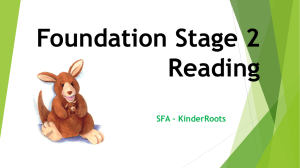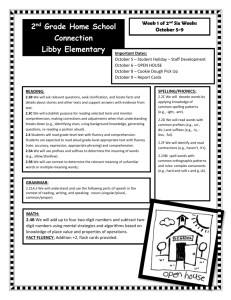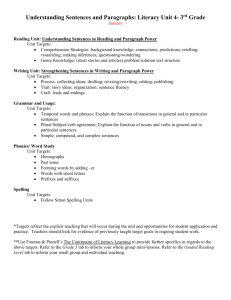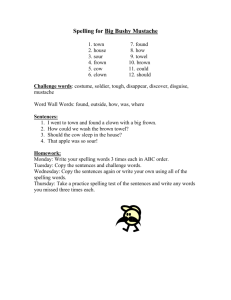GRADE 3
advertisement
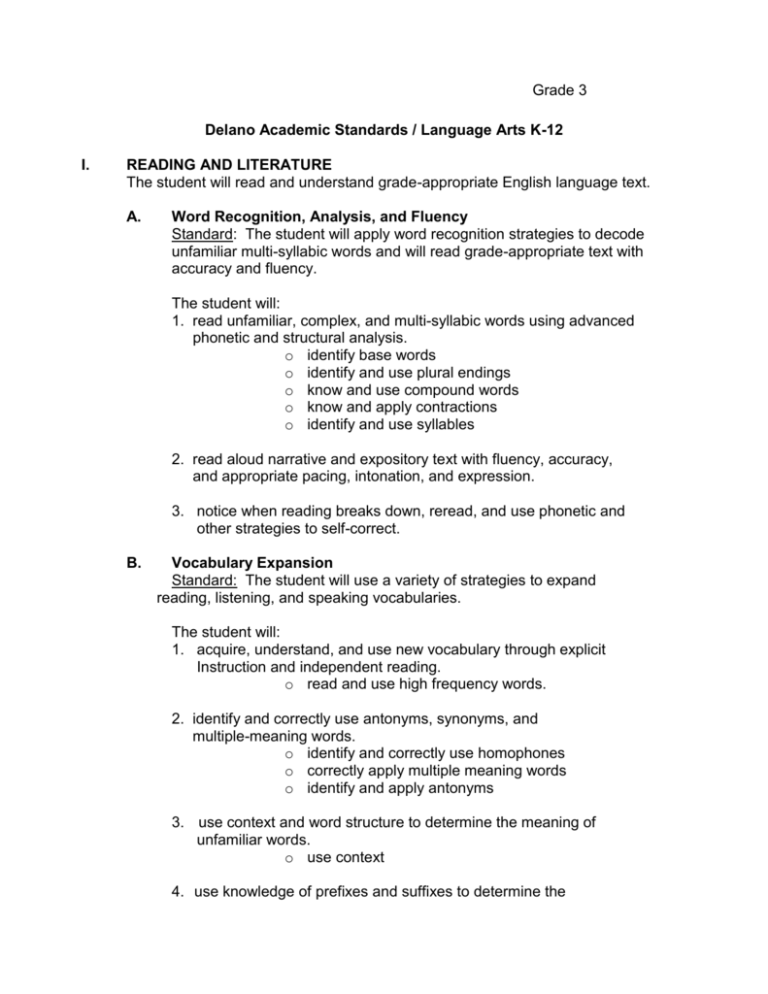
Grade 3 Delano Academic Standards / Language Arts K-12 I. READING AND LITERATURE The student will read and understand grade-appropriate English language text. A. Word Recognition, Analysis, and Fluency Standard: The student will apply word recognition strategies to decode unfamiliar multi-syllabic words and will read grade-appropriate text with accuracy and fluency. The student will: 1. read unfamiliar, complex, and multi-syllabic words using advanced phonetic and structural analysis. o identify base words o identify and use plural endings o know and use compound words o know and apply contractions o identify and use syllables 2. read aloud narrative and expository text with fluency, accuracy, and appropriate pacing, intonation, and expression. 3. notice when reading breaks down, reread, and use phonetic and other strategies to self-correct. B. Vocabulary Expansion Standard: The student will use a variety of strategies to expand reading, listening, and speaking vocabularies. The student will: 1. acquire, understand, and use new vocabulary through explicit Instruction and independent reading. o read and use high frequency words. 2. identify and correctly use antonyms, synonyms, and multiple-meaning words. o identify and correctly use homophones o correctly apply multiple meaning words o identify and apply antonyms 3. use context and word structure to determine the meaning of unfamiliar words. o use context 4. use knowledge of prefixes and suffixes to determine the meaning of unknown words. o recognize and use suffixes o recognize and apply prefixes meaning “opposite” o use and apply prefixes o know and apply inflected endings o know and apply word endings 5. use dictionaries and glossaries to understand the meaning of new words. 6. use Greek/Latin roots. o cor o graph, gram o carn, corp o curr, curs, cours o cycl, orb o syn o dict o phil o foli o cron/temp C. Comprehension Standard: The student will understand the meaning of texts using a Variety of comprehension strategies and will demonstrate literal, interpretive, and evaluative comprehension. The student will: 1. read aloud grade-appropriate text with accuracy and comprehension. 2. recall and use prior learning and preview text, using title, headings and illustrations, to prepare for reading. 3. generate and answer literal, inferential, interpretive and evaluative questions to demonstrate understanding about what is read. 4. retell, restate or summarize information orally, in writing, and through graphic organizers. o identify the story structure and summarize text o sequence events 5. infer and identify main idea and determine relevant details in nonfiction text. o identify topic, main idea, and supporting details o note details 6. monitor comprehension and use strategies to self-correct when needed. 7. follow three-step written directions. o follow directions D. Literature Standard: The student will actively engage in the reading process and read, understand, respond to, analyze, interpret, evaluate, and appreciate a wide variety of fiction, poetic, and nonfiction texts. The student will: 1. read from and listen to American literature as well as literature from other countries. 2. identify, describe, and respond to literary elements of characterization, plot, setting, and theme. o distinguish between fact and opinion 3. identify and describe patterns of sounds such as rhyme and rhythm in poetry. 4. compare and contrast similar works by different authors in the same genre or the same theme. o compare and contrast 5. compare and contrast two works by the same author. o categorize and classify 6. identify and determine the meanings of similes and metaphors. o identify, understand, and use analogies 7. critically read and examine text to determine author’s purpose. o identify the author’s viewpoint 8. respond to literature using ideas and details from the text to support reactions and make literary connections. o make generalizations o identify cause and effect o predict outcomes o make inferences o draw conclusions 9. read from and respond to a variety of fiction, poetic, and nonfiction texts of increasing complexity for personal enjoyment. o differentiate fantasy and realism o make judgments about text II. WRITING (Writing should be addressed across content areas and integrated into the curriculum.) The student will write clearly and coherently to communicate effectively for a variety of audiences and purposes. A. Types Of Writing Standard: The student will compose various pieces of writing. The student will: 1. write in a variety of models to express meaning including: o descriptive o narrative o informative, clarification, problem solving o friendly letter o poetry B. Elements Of Composition Standard: The student will engage in a writing process with attention to organization, focus, and quality of ideas. The following traits of writing will be stressed: ideas and organization, with voice, word choice, sentence fluency, and conventions being introduced. The student will: 1. write a paragraph that includes: o an indented or block style of paragraph o a topic sentence o 3-5 supporting sentences o a concluding sentence 2. use composing processes including: o brainstorming, journaling, sketching, listing, outlining, and determining audience, purpose, and focus o Use verbalization (discussions, interviews, brainstorming and graphic organizers) to prepare for writing o drafting, organizing, supporting and putting ideas into sentences and paragraphs o revising - improving the quality of content, organization, sentence structure, and word choice o publishing - producing a document and sharing the writing with the audience C. Spelling, Grammar, And Usage Standard: The student will apply standard English conventions when writing. (Use of standard English conventions is necessary to help a writer convey meaning to the reader. Spelling, grammar, and usage may be taught as a separate unit as well as integrated into teaching writing processes.) The student will: 1. compose complete sentences when writing. o write a sentence o combine sentences o avoid run-on sentences o identify and use subjects and predicates o identify and write different kinds of sentences 2. recognize and correct spelling errors when writing. 3. spell correctly one and two-syllable words that have blends, contractions, and compounds. 4. spell common homophones correctly. 5. apply grammar conventions correctly in writing including: o nouns - singular, plural, possessive, common, and proper o verbs- past, present, and the verb “be” o adjectives - build sentences with adjectives o pronouns - write clearly with pronouns 6. apply punctuation conventions correctly in w writing including: o periods, question marks, and exclamation points o capitalization of proper nouns o abbreviations o sentence beginnings o commas in a series 7. show growth in spelling. o achieve 80% accuracy on weekly final spelling tests o apply conventional spelling during daily writing D. Research Standard: The student will locate and use information in reference materials. The student will: 1. use grade-level, appropriate reference materials to obtain Information from dictionaries, glossaries, encyclopedias, and the Internet. 2. arrange words in alphabetical order. 3. demonstrate usage of study skills. o read and use schedules. o read a diagram o use maps and globes. o read and use bar graphs 4. create individual research projects. o develop subject o formulate questions o read various resources for ideas o take notes o organize note cards o create topic sentences and provide supporting details E. Handwriting And Word Processing Standard: The student will write legibly. The student will: 1. write legibly, allowing margins and correct spacing between letters in a word and words in a sentence. 2. begin to make the transition to cursive. o use cursive handwriting as introduced and practiced o begin acquiring keyboarding skills III. SPEAKING, LISTENING, AND VIEWING A. Speaking And Listening Standard: The student will demonstrate understanding and communicate effectively through listening and speaking. The student will: 1. participate in and follow agreed-upon rules for conversation and formal discussions in large and small speaking. o stand straight, face group, keep feet still, make eye contact, enunciate clearly, and speak with proper volume o add good ideas in small and large group discussions when it is their turn o briefly and clearly answer questions 2. demonstrate active listening and comprehension. o show social courtesies for listening (pay attention, no distractions, look at speaker, respond to speaker) o restate what was heard and answer questions about descriptions, stories, and informal presentations 3. follow multi-step oral directions. 4. give oral presentations to different audiences for different purposes. o give an informal oral presentation o select, develop, and use visual aids when o speaking in non-distracting way to clarify ideas 5. organize and express ideas sequentially or according to major points. o organize thoughts before speaking o use complete sentences to explain the main ideas 6. perform expressive oral readings of prose, poetry or drama B. Media Literacy Standard: The student will critically analyze information found in electronic and print media, and will use a variety of these sources to learn about a topic and represent ideas. The student will: 1. read print view pictures and video images and identify differences in how information is presented in print and non-print materials. o interpret presentation of data (e.g., charts, tables, graphs) 2. use print, pictures, audio and video to express ideas and knowledge gleaned from the sources.





